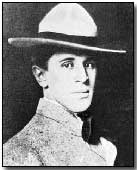Committee on Public Information
The Committee on Public Information (CPI), also known as the Creel Committee, organized publicity on behalf of U.S. objectives during World War I.
In 1917, U.S. President Woodrow Wilson tapped muckraking journalist George Creel [1] to head the CPI. At the time, a strong current of public opinion in the United States opposed Wilson's plan to enter the war in Europe, and in fact Wilson had run for re-election in 1916 on the slogan, "He kept us out of war."
In a 1920 memoir, titled How We Advertised America, Creel wrote that the "war was not fought in France alone":
- It was the fight for the minds of men, for the "conquest of their convictions," and the battle-line ran through every home in every country.
- It was in this recognition of Public Opinion as a major force that the Great War differed most essentially from all previous conflicts. The trial of strength was not only between massed bodies of armed men, but between opposed ideals, and moral verdicts took on all the value of military decisions. ... In all things, from first to last, without halt or change, it was a plain publicity proposition, a vast enterprise in salesmanship, the world's greatest adventure in advertising. ...
- There was no part of the great war machinery that we did not touch, no medium of appeal that we did not employ. The printed word, the spoken word, the motion picture, the telegraph, the cable, the wireless, the poster, the sign-board--all these were used in our campaign to make our own people and all other peoples understand the causes that compelled America to take arms. ... What we had to have was no mere surface unity, but a passionate belief in the justice of America's cause that should weld the people of the United States into one white-hot mass instinct with fraternity, devotion, courage, and deathless determination.[2]
To accomplish these goal, Creel reached out to the entertainment and advertising industries and developing a complex, sophisticated and diverse array of propaganda techniques:
- The CPI trained a nationwide corps of public speakers, called "Four-Minute Men," to go into movie houses or other public functions and deliver brief speeches urging their neighbors to buy Liberty Bonds, donate to the Red Cross or join the armed forces. According to the committee's records, 75,000 Four-Minute Men and women made a total of 7,555,190 speeches in 1917 and 1918.
- Creel recruited filmmakers to produce pro-war silent features with titles such as "Pershing's Crusaders" that were shown in theaters around the country, often to the accompaniment of pianos in the movie houses thumping out patriotic songs. Silent movie stars such as Charlie Chaplin addressed crowds of thousands at war bond rallies.
- The CPI published "Red, White and Blue Books," containing essays by prominent academics and historians who argued in support of the Allied cause.
- The CPI's Division of Pictorial Publicity, headed by illustrator Charles Dana Gibson, who in turn gathered a corps of talented colleagues to develop the posters urging people to buy bonds or enlist in the army.[3] The posters often depicted the German enemy as a bloodthirsty savage, "the Hun." The Division of Pictorial Publicity turned out 1,438 different designs for posters, window cards, newspaper advertisements, cartoons, seals and buttons. Its most famous poster, featuring a stern, finger-pointing Uncle Sam saying "I Want You," was drawn by illustrator James Montgomery Flagg.
- The Creel committee also issued more than 6,000 news releases and 200,000 "lantern slide" shows. It used Boy scouts to deliver annotated copies of President Wilson's addresses to American homes. Fortnightly periodicals were sent to 600,000 teachers. Chambers of commerce, churches, fraternal societies and schools were used as channels of distribution for CPI propaganda.
Historian Robert H. Zieger calls the work of the CPI "an outstanding success. A vast army was raised. A polyglot population showed few signs of disloyalty or disaffection. Liberty Loan drives were all oversubscribed, Red Cross contributions and a dozen other war -support causes were successful." But while the Creel committee's efforts to sell the war were successful, its slogans of "the war to end war" and "making the world safe for democracy" were cruel illusions. In reality, the First World War laid the seeds for the rise of fascism, followed by the Second World War and a series of subsequent wars from which peace has yet to emerge.
Contents
Articles and resources
Related SourceWatch articles
References
External Resources
- George Creel, How We Advertised America (New York: Harper & Brothers, 1920).[4]
- George Creel, "The Battle in the Air Lanes," Popular Radio, September, 1922, pp. 3-10.
- John Hanc, "Rallying the Public: A look back at government efforts to 'spin' a war," Newsday, December 5, 2001, Part II, p. B03.
- Renee Yeh, "Creel Committee" (student project, University of San Diego)
